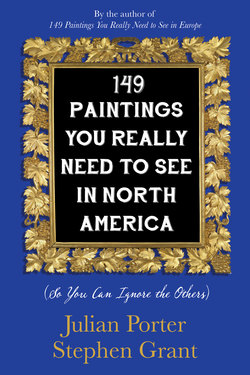Читать книгу 149 Paintings You Really Need to See in North America - Julian Porter - Страница 9
На сайте Литреса книга снята с продажи.
Chapter 2
ОглавлениеBuffalo, New York
Albright-Knox Art Gallery
13. Gotham News (1955)
Willem de Kooning (1904–97)
Willem de Kooning, Gotham News, 1955
Oil on canvas, framed: 181.61 x 208.3 x 7 cm; support: 175.3 x 200.7 cm
Gift of Seymour H. Knox Jr., 1955
Albright-Knox Gallery, New York
© 2017 The Willem de Kooning Foundation /ARS, New York / SODRAC, Montreal
Photo credit: Albright-Knox Art Gallery / Art Resource, NY
Willem de Kooning calls to mind Kurtz’s final lines in Conrad’s Heart of Darkness , “The horror, the horror,” such is the sheer, transgressive power of his work. Yet the resolution ultimately becomes reflective and resonant, offering the viewer sublime enjoyment for her efforts.
Born in the Netherlands, de Kooning eventually found his way to New York, stopping in New Jersey on the way. There he worked as a house painter! Once in Manhattan, he engaged in a few projects in commercial art, designing fashion advertisements.
His prodigious output alone leaves many of his contemporaries in the dust. The critical feature of de Kooning’s work — that which sets him apart from most artists, except perhaps Picasso — is his juxtaposition of abstraction with forms and shapes. He merged Cubism, Surrealism, and Expressionism into one form, always playing with figure and the background, distorting and diffusing the figure on the canvas, best seen in his Woman series.
De Kooning worked on the Woman series on and off for thirty years. His form of Abstract Expressionist painting was unlike anything on the current art scene. Woman was also a departure for de Kooning in his use of colour. As the Woman series continued throughout his career, viewers can observe the progression of de Kooning’s melding of abstraction and form. In Woman (1950–1952), the figure is contorted and manipulated to force a blending into the background and become indistinct from the canvas, leaving critics to suggest a certain misogyny, given its violence of form. Whether this is so, he had an open and tumultuous marriage to the artist Elaine de Kooning from 1943 until his death, including a twenty-year hiatus in the middle.
Here, Gotham News reflects the action and frisson of a large urban centre, featuring reportage in the form of newsprint in the lower left corner. Yes, this concatenation of colour might prove frightening to the naïve or uninitiated but might this be a nod toward the superhero Batman at the rescue? Perhaps.
De Kooning’s work is found at major museums across North America, including the Philadelphia Museum of Art — home to seven of his works — as well as at the Art Institute of Chicago.
SG
14. Six in Vermilion with Red in Red (1970)
Patrick Heron (1920–99)
Patrick Heron, Six in Vermilion with Red in Red, 1970
Screen print, 59/100, sheet: 72.4 x 101.6 cm
Gift of Robert Borns, 1980
Albright-Knox Art Gallery, New York
© Estate of Patrick Heron / SODRAC (2017)
Photo credit: Albright-Knox Art Gallery / Art Resource, NY
A stylish adventurer into abstraction, influenced greatly by his exposure to Cézanne, Patrick Heron was born in Leeds, England, in 1920. He came to observe his contemporaries Georges Braque and Henri Matisse, the former of whom gave Heron the motivation to paint his own Abstract Expressionist paintings, the latter of whom spurred his use of colour.
Creating a dynamic tension between colour and space, in Six in Vermilion with Red in Red (1970), there is not so much a conflicting presence of colour that overwhelms the viewer; rather, Heron generates movement and a vague sense of form through the emergence of colour. For Heron, as for many other late twentieth-century painters, abstraction was the vehicle to provoke thought and contemplation, leaving the viewer to discern meaning, if any.
In 1956, after a Tate London show of Rothko and Newman, Heron embarked on creating a broad collection of abstract paintings, drenching his canvases in a variety of colours to merge the pigment in a robust and striking way. Like ocular caffeine, a jolt to the eye.
Heron died in 1999, but left a painting and literary legacy as a critic behind. Although much of his work is now held privately and not predominantly featured in North America, some galleries that show his work are the San Diego Museum and the Boston Museum of Fine Arts.
